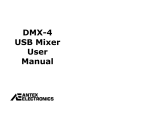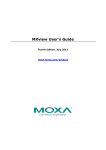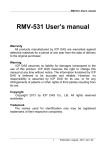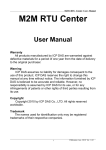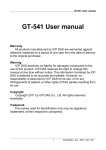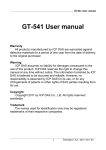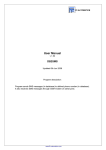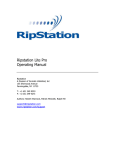Download User Manual Version 2.0
Transcript
Wireless Sensor Network Sniffer/Analyser (IEEE 802.15.4 / ZigBee® version) User Manual Version 2.0 User Manual Version 2.0 PLEASE READ THE NO WARRANTY, NO LIABILITY STATEMENTS AND TRADEMARK INFORMATION DESCRIBED ON THE LAST FEW PAGES OF THIS USER MANUAL BEFORE USING THE PRODUCT OR THE DOCUMENT FURTHER. Page 2 User Manual Version 2.0 Table of Contents 1 WiSens® Classic – Introduction..........................................................................................7 1.1 WiSens® – The ZigBee® technology development tool .......................................................7 1.2 Pre-requisites for using WiSens®...........................................................................................7 1.3 Hardware and software of WiSens® ......................................................................................7 2 1.3.1 Hardware Required....................................................................................................8 1.3.2 Software Required ......................................................................................................8 1.3.3 WiSens® Hardware....................................................................................................9 Installing WiSens® Classic ................................................................................................10 3 2.1.1 Uninstalling WiSens® ..............................................................................................10 2.1.2 Installing WiSens®...................................................................................................11 2.1.3 Uninstalling WiSens® ..............................................................................................14 Understanding WiSens® GUI ...........................................................................................15 3.1 Starting WiSens® Classic.....................................................................................................15 3.2 Menu and Tool Bar...............................................................................................................16 3.3 3.4 4 3.2.1 File menu..................................................................................................................16 3.2.2 Help menu ................................................................................................................16 3.2.3 Tool Bar....................................................................................................................16 Bottom Pane .........................................................................................................................17 3.3.1 Hiding the bottom pane ............................................................................................18 3.3.2 Status Bar .................................................................................................................18 Hardware Information ..........................................................................................................19 Working with WiSens®......................................................................................................20 4.1 Capturing a session...............................................................................................................20 4.1.1 Configuring the COM port .......................................................................................20 4.1.2 Configuring data packet properties .........................................................................21 Page 3 User Manual Version 2.0 4.2 Opening a session .................................................................................................................23 4.2.1 Saving a session .......................................................................................................23 4.2.2 Setting up display characteristics.............................................................................23 4.3 Node Identification ...............................................................................................................24 4.4 Display Manager...................................................................................................................25 4.5 Node-Packets graph..............................................................................................................25 4.6 Printing .................................................................................................................................26 5 Error Messages ...................................................................................................................28 6 IMPORTANT INFORMATION, DECLARATIONS.....................................................29 Page 4 User Manual Version 2.0 Table of Figures WiSens® USB stick....................................................................................................................................... 9 Uninstalling WiSens®.................................................................................................................................. 10 Uninstalling WiSens®.................................................................................................................................. 10 WiSens® Setup wizard ............................................................................................................................... 11 Selecting installation folder ......................................................................................................................... 12 Confirm Installation ..................................................................................................................................... 13 Completion of installation message ............................................................................................................ 13 Uninstalling WiSens®.................................................................................................................................. 14 Uninstalling WiSens®.................................................................................................................................. 14 WiSens® Screen......................................................................................................................................... 15 File menu..................................................................................................................................................... 16 Tool bar ....................................................................................................................................................... 17 Tabs at bottom pane ................................................................................................................................... 17 View with the bottom pane hidden .............................................................................................................. 18 Status bar .................................................................................................................................................... 18 A selected packet........................................................................................................................................ 19 Hardware Handshake Data......................................................................................................................... 19 Configuring COM port ................................................................................................................................. 20 Configuring the sniffer ................................................................................................................................. 21 Capturing data packets ............................................................................................................................... 21 Session on display ...................................................................................................................................... 22 Display options ............................................................................................................................................ 24 Node Identification tab ................................................................................................................................ 24 Display Manager ......................................................................................................................................... 25 Node-Packets graph ................................................................................................................................... 25 Navigating through Node-Packets Graph ................................................................................................... 26 Page 5 User Manual Version 2.0 Print Preview ............................................................................................................................................... 27 Page 6 User Manual Version 2.0 1 WiSens® Classic – Introduction The words WiSens® Classic and WiSens® mean the same in the scope of this document, and they are used interchangeably in this document. WiSens® is a wireless sensor network sniffer/analyser tool, which meets the needs of engineers in the IEEE 802.15.4/ZigBee® development and deployment domain. It detects and captures wireless radio signal packets in the ambience during a testing/ commissioning session and presents them in convenient graphic displays. WiSens® presents users with a wide variety of choices in displays to help them evaluate, diagnose and fix wireless communication related issues/bugs. Further, each session can be saved, printed or attached as electronic documents, which can be archived for future analysis or for attachment as test records. WiSens® captures all conversations between devices/nodes in a network, communicating in a specified channel, just as you would capture a chat session with a friend. The sentences give way to packets, graphically displayed – and you see the conversation! The packets are captured, displayed and stored sequentially, and can be traced to which device communicated to which other device and at what time. If there is a glitch, you see it in vivid detail on the screen, making it is easy to diagnose and fix a problem. Meet Dr.Bee, our friendly diagnostic specialist and consultant mascot for BzWorks’ products, gives valuable tips and suggestions that allow the user to enjoy maximum performance from usage of BzWorks’ products. 1.1 WiSens® – The ZigBee® technology development tool WiSens® is a tool for professionals who work on IEEE 802.15.4 and ZigBee® technology hardware, communication stack software development and application developments. It is used to sniff (detect) IEEE 802.15.4 PHY/MAC radio signal packets with encapsulated ZigBee 2004, 2006 of 2007 frames transmitted in a specified channel. The packets sniffed are filtered as per the user defined settings, decoded and displayed. 1.2 Pre-requisites for using WiSens® As the packets are displayed according to IEEE 802.15.4 and ZigBee® specifications, users are expected to possess some knowledge of these formats in order to work effectively with this tool. 1.3 Hardware and software of WiSens® WiSens® Classic is a product consisting of hardware and software components: Page 7 User Manual Version 2.0 Sniffer hardware (USB stick) Sniffer software loaded on to the PC For the sniffer hardware used, the corresponding USB driver software needs to be installed separately by the user. 1.3.1 Hardware Required The hardware required to setup a complete sniffer system is tabulated below: Sl. No. Description Qty Remarks 1 PC – Pentium 4 or above/equivalent with USB port and a minimum of 512 MB RAM 1 User to arrange 2 WiSens® sniffer – (USB stick) 1 Deliverable by BzWorks I strongly recommend usage of Pentium 4 or better versions of the hardware for best results. A minimum of 512 MB RAM is needed to run the application well. The higher the RAM capacity, the better the sniffing and packet capture performance. 1.3.2 Sl. No. Software Required Description Remarks 1 WiSens® Classic sniffer software (version as sold or as updated latest at the website) Deliverable by BzWorks 2 Windows XP Professional, Vista, 7 User’s responsibility 3 .NET Framework 2.0 User’s responsibility WiSens® Classic needs .NET framework version 2.0. User is required to download the free distribution of .NET framework version 2.0 (available at http://www.microsoft.com/downloads/en/details.aspx?FamilyID=0856eacb-43624b0d-8edd-aab15c5e04f5&displaylang=en) before installing WiSens® Classic. Page 8 User Manual Version 2.0 1.3.3 WiSens® Hardware The WiSens® hardware is supplied as a compactly packed and sleek USB stick housing (see picture below). WiSens® USB stick Data sheets for the supported hardware are available at www.bzworks.com/downloads. Page 9 User Manual Version 2.0 2 Installing WiSens® Classic Before starting installation of a newer version of WiSens®, uninstall the older version if any, first. 2.1.1 Uninstalling WiSens® To uninstall WiSens®, Click Start > Programs > WiSens® Packet Sniffer > Uninstall Uninstalling WiSens® Dialog box as below appears: Uninstalling WiSens® Select Remove WiSens_Packet_Sniffer. Click Finish to uninstall. WiSens® Classic is uninstalled now. You are ready to install now. Page 10 User Manual Version 2.0 2.1.2 Installing WiSens® WiSens® software can be easily installed following onscreen guided steps. To install WiSens®: Insert CD supplied along with the hardware Select Your CD drive and open Double click . Opens dialog box as below: WiSens® Setup wizard Click Next. Opens Page 11 User Manual Version 2.0 Selecting installation folder Click Next Page 12 User Manual Version 2.0 Confirm Installation Click Next. The program installs and displays completion message. Completion of installation message The icon is placed on your desk top after the installation is completed. Also the Start menu lists WiSens® Packet Sniffer as a short cut to access the software. Page 13 User Manual Version 2.0 2.1.3 Uninstalling WiSens® To uninstall WiSens®: Click Start > Programs > WiSens® Packet Sniffer > Uninstall Uninstalling WiSens® Dialog box as below appears: Uninstalling WiSens® Click Finish to uninstall Page 14 User Manual Version 2.0 3 Understanding WiSens® GUI To get started, check if: 3.1 • WiSens® Classic is installed on your PC • The WiSens® hardware is connected to the PC’s USB or serial ports. Starting WiSens® Classic The installation, when completed places an icon To start WiSens®, double-click the below: on the desktop. icon on the desk top. The application opens as shown Packets display area This bottom pane lets you set properties, navigate etc. You can hide this pane and have the entire screen for display of packets. WiSens® Screen The user can control the display content using the fields for user inputs on the pane at the bottom of the window. Page 15 User Manual Version 2.0 3.2 Menu and Tool Bar The menu bar comprises simple File and Help menus. 3.2.1 File menu The file menu with all its sub-menus is pictured below. The file menu facilitates opening a new file or a saved file. It also helps in saving and printing the sessions. File menu The sub-menus are explained elsewhere in detail. 3.2.2 Help menu The contents of the help menu and how to use it will be captured here. 3.2.3 Tool Bar The WiSens® application presents a set of tools at the tool bar to help users easily and quickly perform required tasks. Page 16 User Manual Version 2.0 Opens new session, clears current session Start/Stop Capture Opens a stored session Select Channel Saves current session Show/Hide bottom pane Configure WiSens® View data Packets in WiSens® Classic Mode View data Packets in raw data mode Print View data Packets in Black, white and grey mode Print preview Tool bar 3.3 Bottom Pane The pane at the bottom of the window has six tabs as below: Tabs at bottom pane This pane can be hidden when you desire to have the full screen for viewing the packets. This pane is very important as here you control the properties of the display. Following table presents the basic objectives of each of the tabs in the bottom pane. Tab Description Hardware Info The hardware details are displayed Configure This tab allows user to set the properties of the session to be captured such as the channel, the time with its unit, the display characters etc. Node Identification All the nodes participating in a session are registered and listed in this pane along with its PAN ID, short address and IEEE address Display Manager The user sets the display properties in this tab Page 17 User Manual Version 2.0 Node-Packets Graph 3.3.1 This tab complements packets view. The time line helps user analyse and navigate to the correct frame for viewing in the display pane. Hiding the bottom pane To hide the bottom pane: Click File > Show/Hide or Click View with the bottom pane hidden 3.3.2 Status Bar The status bar at the bottom of the window dynamically displays vital information such as packet counts, packet buffer size, filter status and selected packet index. Status bar Packet counts - Displays the total number of packets captured during a session. Page 18 User Manual Version 2.0 The packet buffer size - The packet buffer size is set by the user as part of setting the properties using Configure tab. The packet buffer size display at the status bar captures the extent of usage of the buffer in percentage. Selected packet index - Displays the sequential number of the packet, which is selected at any given moment Filter - Indicates whether the filter is ON or OFF. The packet selected has a distinctly marked blue background (cursor) as below: A selected packet 3.4 Hardware Information The tab ‘Hardware Info’ at the bottom pane displays the sniffer hardware data: Hardware Handshake Data Page 19 User Manual Version 2.0 4 Working with WiSens® This session details how to capture / open a session and work around to derive optimum benefit. 4.1 Capturing a session The first and foremost requirement to start work with WiSens® is to set the communication settings, set the channel number and other parameters in which the sniffing to be carried out etc. 4.1.1 Configuring the COM port To configure the communication port: Click File > Configuration or Click . Opens following dialog box. Configuring COM port Set the port, baud rate and buffer sizes as shown in the figure above and click Configure. Page 20 User Manual Version 2.0 4.1.2 Configuring data packet properties The Configure tab allows you to set some of the properties of parameters you need for the display. Configuring the sniffer Select the channel at which you need the sniffer active from the Channel drop down menu. The channel selected should be the one at which the target PAN is operating. For 2.4 GHz, transceivers channel numbers 11 to 26 are valid selections. The channel numbers field accepts hexadecimal values equivalent to values 11 to 26. Enter the value and click Set Channel. Select the unit of time for display in the packet at the Time field drop down menu Select the parameter for display along with the sniffed packets at Show field drop down menu If you require packet Index displayed at the status bar at the bottom of the window, check mark the check box for Packet Index The sniffer is now ready to capture the packets in the ambience. To start capture: Click or Click File > Start Capture The system automatically clears the display on the screen prior to start of any capture session. Capturing data packets While viewing display of packets of a session, the focus can be easily shifted from one layer to Page 21 User Manual Version 2.0 another i.e. even as the capture is APSDU, for the same packet you can chose to view up to only the MSDU in order to have a closer study and switch to APSDU view or to NSDU views. This kind of switching views only affects the display and not the captured packets during a session. Session on display Click MAC Fields to view IEEE 802.15.4, protocol packets Click NWK Fields to view ZigBee® Network protocol packets Click APS Fields to view ZigBee® Application Support Sub-layer protocol packets For each of the packet received, the user can select/deselect any of the following parameters for display on screen (i) Packet Index (ii) Length (iii) Source (iv) Time (v) LQI/RSSI (vi) FCS Page 22 User Manual Version 2.0 For the same packet all the three different modes of viewing are available. viz., WiSens® Classic Mode, Black, White, Gray Mode and Raw Data Mode. While WiSens® Classic mode offers the best choice of colors, the Black, White, Gray mode is good for printing to a non-color printer while the raw data mode shows the raw over-the-air packet in hexadecimal bytes. 4.2 Opening a session To open an archived session: Click File > Open or Click Browse to the folder in which the stored file is available and select the desired file Click Open 4.2.1 Saving a session To save a captured session: Click File > Save As. The Save As dialog box opens or Click Browse to the folder in which to save the session Enter a name for the file Click Save 4.2.2 Setting up display characteristics The display can be set for the colourful WiSens® classic or grey scale. To set display properties: Click File > Display > WiSens® Classic or Click Or Click File > Display > Black, White Gray or Click Page 23 User Manual Version 2.0 Display options 4.3 Node Identification Every device that joins the network is automatically registered and listed under this tab. Node Identification tab helps you manage the housekeeping tasks. The nodes listed here appear in TimeLine view. Often times the list gets unwieldy with a number of inactive nodes cluttering the view. This tab helps you remove the inactive nodes and maintain an uncluttered view in Timeline tab. Node Identification tab Each device is identified in the list with its node name, the PAN ID to which the node is joined, the short address and the IEEE extended address. Move Up and Move Down buttons help you navigate the list. Any selected list item can be removed from the list using the Remove button. The fields at the right help you to quickly accomplish the task of removing a node from the list by selecting the node using the drop down menus. You can also manually add to the list by entering a node name, PAN ID, short address and Page 24 User Manual Version 2.0 IEEE address and clicking the Add button. 4.4 Display Manager Display Manager allows you to select/focus the display to present the details you wish to see/analyze. This powerful feature adds to the flexibility and versatility of WiSens®. Display Manager At the list box at left you can choose any one or a combination or all packet types in a ZigBee® network (Beacon, Data, Acknowledgement, and Command) for viewing. After selecting the desired combination of data packets for viewing click Apply Filter to get the display reflect your choice. The Reset Filter button reverts the display to default display i.e. all the packets in view. The TurnOff Filter renders all filtering ineffective. Further filtering options to the users presented is selection of Destination and Source addresses. The display renders only the transmission packets between the selected addresses. Alternatively the desired nodes can be selected from the list at the list box for Destination Node and Source Node and clicking the Include button. The Remove button takes the selected node off the display. 4.5 Node-Packets graph Node-Packets Graph tab offers a convenient navigation and valuable visual depiction of important information like missing packets, the node whose packet is missing and the ability to quickly view the group of packets in question. The blue vertical bar in can be moved across in the horizontal plane to focus the view on to the packets of interest in the display pane at the top. The green vertical line seen on either sides of the blue line demarcate the group of packets on display. Node-Packets graph The horizontal time line bar at the top of the tab view time correlation for each packet captured during a session by the sniffer. Page 25 User Manual Version 2.0 The orange cross mark x appears at the coordinate to correlate the device which transmitted and the time at the top horizontal scale. Following figure illustrates how to select a packet at the Node-Packets Graph tab. Navigating through Node-Packets Graph Note that the selected packet is high-lighted with a blue background 4.6 Printing To print: Click File > Print. Print dialog box opens Set all the print settings including the number of copies and paper orientation Click OK WiSens® fits the packet length in more than one line in case it is too long. It breaks the packet and shifts the excess length to the next line, thus completing the entire display of the packet for convenient viewing. Page 26 User Manual Version 2.0 Print Preview Page 27 User Manual Version 2.0 5 Error Messages In the event of a suspected malfunction – minor or major, WiSens® generates several intuitive error messages to caution the user to take remedial action. As the nature of the error messages are self-explanatory, we do not list them here. In the event of any serious errors that the user encounters or would like to find out more about particular error messages, please contact BzWorks support personnel by emailing them at [email protected] or by reporting the error at www.bzworks.com/support. Page 28 User Manual Version 2.0 6 IMPORTANT INFORMATION, DECLARATIONS NO WARRANTY WiSens® Classic is provided “as is” and use of WiSens® is at licensee’s risk. BzWorks expressly disclaims all warranties, representations of conditions of any kind, express or implied or statutory, including but not limited to, any warranty of merchantable quality or fitness for a particular purpose and any warranty that WiSens® is delivered free of any third party claims by way of infringement or otherwise. BzWorks does not warrant nor make any condition or representations that the functions contained in WiSens® will meet the requirements of the licensee, that the operation of WiSens® will be uninterrupted nor error free or virus free that defects in WiSens® will be corrected. Further, BzWorks does not warrant or make any conditions or representations regarding the use or the results of the use of WiSens® in terms of its correctness, accuracy, reliability or otherwise. No oral or written information or advice given by BzWorks or others shall create a warranty, condition or representation or in any way extend the scope of the “as is’ provision WiSens®. NO LIABILITY The entire risk as to the results and performance of this WiSens® is assumed by licensee or purchaser. Neither BzWorks nor its affiliates, distributors, resellers, suppliers, agents, officers and directors shall have any liability to licensee or to any other person or entity for any damages howsoever caused including, but not limited to, direct, indirect, incidental, special, general, consequential, punitive or exemplary damages whatsoever including, but not limited to, loss of revenue or profit, damages to property or persons, lost or damaged data, or other commercial or economic loss, even if BzWorks has been advised of the possibility of such damages or they are foreseeable, or for claims by third party. BzWorks’ maximum aggregate liability and that of its affiliates, distributors, resellers, suppliers, agents, officers and directors to licensee shall not exceed the amount paid by the licensee for WiSens®. This section shall apply whether or not the breach, default, nonperformance of failure is a breach of fundamental condition or term, or a fundamental breach. In no event shall licensor be liable to the other party for any loss or injuries to earnings, profits or good will, or for any incidental, special, punitive or consequential damages of any person or entity whether arising in contract, tort or otherwise, even If either party has been advised of the possibility of such damages. Copyright Information for the Manual Copyright 2005-2011. BzWorks. All rights reserved. This program is protected by US and International copyright laws. Warning: This program is protected by copyright law and international treaties. Unauthorized reproduction or distribution of this program, or any portion of it, may result in severe civil or criminal penalties, and will be prosecuted to the maximum extent possible under the law. Disclaimer for the Manual BzWorks have taken care in preparation of this manual, but make no expressed or implied warranty of any kind and assume no responsibility for errors or omissions. No liability is assumed for incidental or consequential damages in connection with or arising out of the use of the information or programs contained herein. Information contained in this publication regarding device applications and the like is Page 29 User Manual Version 2.0 provided only for your convenience and may be superseded by updates and is subject to change without notice. Trademark Information ©Copyright Bzworks Pte Ltd, 2005-2011. WiSens® is a registered trademark of BzWorks Pte Ltd. Other trademarks or registered trademards are the property of their respective manufacturers or owners. Price & Specifications Price and specifications are subject to change without notice. Page 30






























